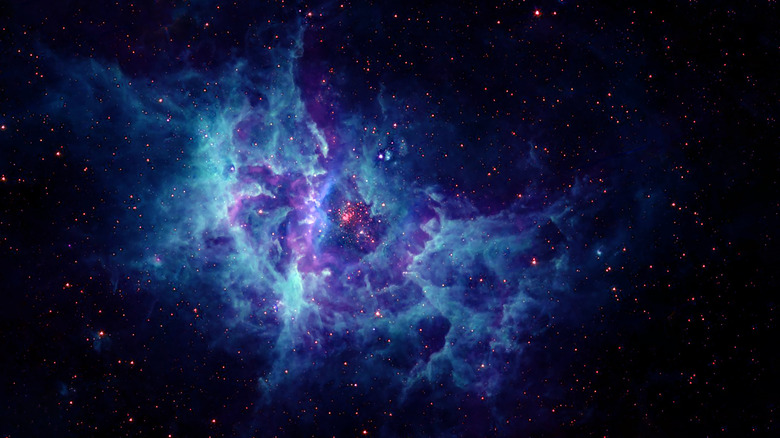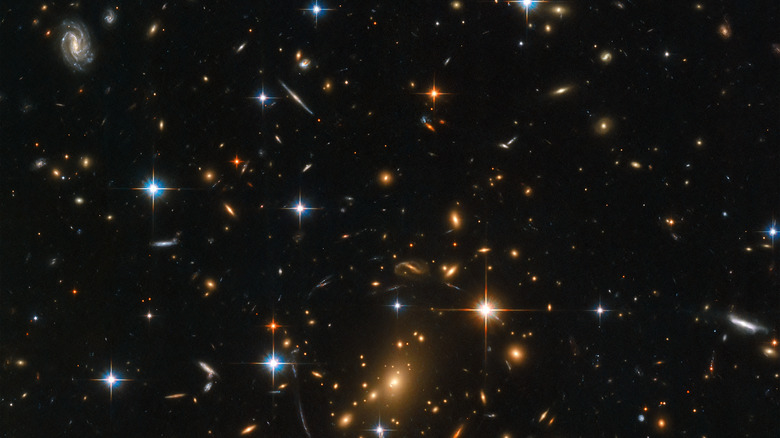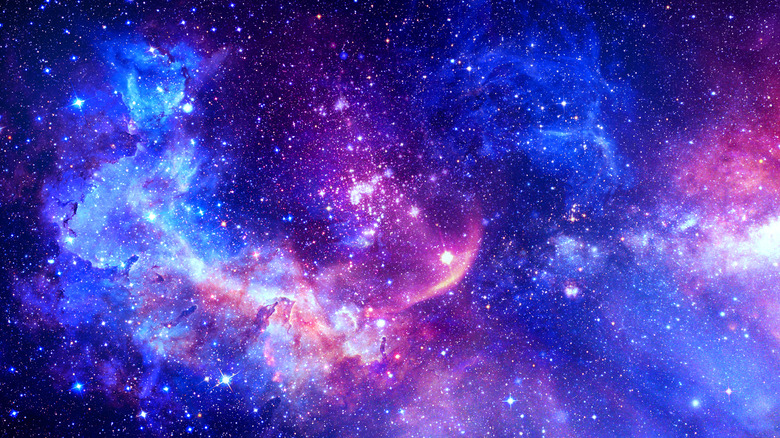What Is Dark Matter And Is It On Earth?
According to NASA, dark energy is estimated to make up around 68% of the universe, while dark matter is 27%. The remainder, less than 5%, is everything that exists as we know it as "regular" matter, from planets to refrigerator magnets. Let's take a closer look at why dark matter is so mystifying, and the possibility of its existence on Earth.
According to Forbes, the notion began to be explored in the early 17th century. Isaac Newton's universal gravity theory allowed astronomers to explore the idea of objects that didn't really emit light and could be detected only by the way the force of gravity caused them to influence other bodies in space. This concept was further honed over the next two centuries until E. E. Barnard's pioneering work on dark nebulae, which (per Brian Koberlein) are mysterious clouds of tiny dust particles. So tiny are these particles that they absorb almost all visible light.
According to Space, the visible elements of the universe as we know it are made of baryonic matter, consisting of electrons, neutrons, and protons. These are the vital building blocks of all known and understood matter, but it's unclear where they feature in the makeup of dark matter. It's suggested that such matter could be baryonic, or it could not.
The most perplexing particles in the universe
The difficult part is explaining the two major elements of dark matter — its seemingly huge dominance of the universe and the sheer challenge of detecting it — in a single theory. It is suggested that dark matter could be made up of what scientists call WIMPs, or weakly interacting massive particles. According to Universe Today, these particles may be the primary ingredient of dark matter, they may be the sole ingredient, the matter might consist of just a small dash of WIMP, or these particles might not feature in the makeup at all.
Space suggests that this idea holds weight, though. WIMPs are estimated to have up to 100 times more mass than protons, while (as the name suggests) having such limited reactions to familiar matter that they're difficult to find. That's one explanation for the curious characteristics of dark matter, but everything remains hypothetical.
Like dark nebulae, Space reports, dark matter also emits no (or negligible at best) light. The detection and study of it has been a tremendous headache for astronomers for over 100 years, though breakthroughs have been made. In 2016, for instance, a vast and fascinating galaxy dubbed Dragonfly 44 was discovered in the Coma constellation (via W.M. Keck Observatory).
Dark matter detected, kind of
The galaxy was found by the W.M. Keck Observatory's telescope in Hawaii, one of the most powerful on the planet. Astronomers noticed that it had relatively few stars and wouldn't have been able to sustain itself unless there was something else there. Many complex calculations later, and it was theorized that the mass of this galaxy might be as much as one trillion times the mass of the sun. 99.99% of Dragonfly 44's mass, then, consists of the unseen and scarcely detectable dark matter.
As for what it definitively consists of, that largely remains a mystery. Science Focus explains that, for the Big Bang to have created the universe as we know it, dark matter needs to consist of something more than the simple gas clouds and dust that make up much of the detectable objects of space.
Starts With a Bang states that all galaxies, like Dragonfly 44, have a mass that isn't fully accounted for by regular matter. This would also be true of the Milky Way, and, by extension, the Earth too. Though there is believed to be much less dark matter on and around the planet than in the center of the universe, Starts With a Bang suggests that there is an infinitesimally small amount of dark matter inside us all right now: an estimated one nanogram total combined inside every human on Earth.
Earth's dark matter "hairs"
In 2015, NASA went one brilliantly outlandish step further, suggesting that dark matter can not only be found on Earth but that it's probably hairy. This odd notion comes from Gary Prézeau at the NASA Jet Propulsion Laboratory in California. Prézeau postulated that the dark matter in the universe exists in long, connected strings, similar to webs or hairs.
Simulations, NASA reports, have demonstrated that dark matter consists of mysterious "streams," which travel and orbit all manner of galaxies at the same speed. Apparently, these hairs of dark matter could travel directly through a planet entirely unimpeded, in a way that the familiar matter we know and can understand could not. In doing so, per Prézeau's analysis, dark matter becomes denser and more concentrated, and several of these peculiar hairs could be protruding from the Earth right now.
The so-called roots of these hairs, Prézeau explained, would be the points richest in dark matter particles, and in fascinating data about this enigmatic material. Sadly, direct detection of them continues to elude humanity. Thanks to pioneering studies such as these, though, science is getting ever closer to unraveling the mystery.



